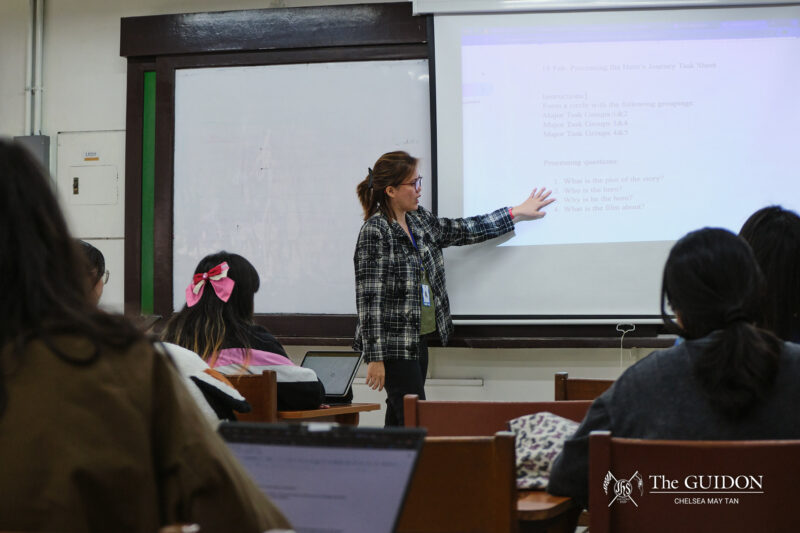Word quickly spread not only in the University of Santo Tomas (UST), but also in the Ateneo, that The Varsitarian, UST’s official student newspaper, released an editorial entitled “Dishonest, mediocre, and anti-poor” last November.
“By issuing a statement supporting the population control bill…the 14 Catholic members of the other Catholic university—the Ateneo de Manila—betray the canker that may eat into any Catholic institution that, while inherently holy, has tendencies toward evil,” The Varsitarian’s editorial begins.
“Star Wars calls it the Dark Side, St. Thomas Aquinas calls it concupiscence. We simply call it intellectual dishonesty,” the editorial continues.
The Varsitarian’s editorial was a backlash incurred by a paper composed by 14 Ateneo professors, titled “Catholics can support the Reproductive Health (RH) Bill in good conscience.” The paper used tenets of Catholic social teaching, as well as empirical research, to support its arguments on the population bill.
“We are…deeply disturbed and saddened by calls made by some members of the Catholic Church to reject a proposed legislation that promises to improve the wellbeing of Filipino families, especially the lives of women, children, adolescents, and the poor,” the paper says.
The 14 Ateneo professors say that the population bill is, “in fact, ‘pro-life,’ ‘pro-women,’ and ‘pro-poor,’” though clarifying that their stand is not the University’s stand.
Horsemen of the Apocalypse?
An editorial is an opinion piece that reflects the stand of a newspaper. It does not necessarily reflect the stand of majority of its target readers, such as in the case of the studentry in the Ateneo, or in UST. The editorial speaks to the reader rather than for the reader.
The Varsitarian’s editorial rebutted the professors’ paper by saying that the population bill is anti-youth, pro-abortion, anti-life, and anti-development. Many Ateneans have criticized the editorial for arguing its points ad hominem, or by using personal attacks instead of attacking the paper’s content.
A statement from the editorial, for example, expresses shock over the “academic mediocrity” of the professors. It also says, “Their support for the population bill is backed by the intellectual school of doomsday social science.”
While rebutting the professors’ paper on other points, the editorial also called the 14 professors “Grim Reapers,” “Horsemen of the Apocalypse,” “Wolf-criers,” “doomsday pundits,” and “divination experts.”
Varsitarian Editor in Chief Anthony Andrew Divinagracia says this is not ad hominem. “We attacked the stand of the 14, not their person,” he says.
“Modern newspapers have written a lot of polemics…in that kind of style, to some extent, name-calling is allowed,” he adds.
Polemics pertain to an aggresive attack to refute an opinion. Divinagracia says newspapers who name-call President Gloria Macapagal-Arroyo, for example, practice this style.
“It’s the style of the editorial to be combative, to be aggressive, and then, of course, it’s also the style of the editorial to be friendly, to be congenial,” says Varsitarian Publications Adviser Joselito Zulueta, who is also part of the Philippine Daily Inquirer’s editorial board and UST’s Journalism Department faculty.
Zulueta says the editorial wanted to point out that the 14 professors should not have twisted Catholic social teachings in their paper. “Since you [14 professors] are Catholics, or educators of a Catholic institution…you should at least have acquainted yourselves in the body of Catholic teachings that pertain to Catholic faith and morals.”
“If you don’t agree with the minutiae of these teachings, then you should at least keep your traps shut,” he says.
Zulueta says the editorial’s polemical style was an effort to attract more readers, too. The point was to come up with strong points to prevent the editorial from being boring.
“We’re just looking for creative synonyms for alarmists, doomsday sceneries… There’s nothing malicious or libelous about that. I’m very, very careful with libel,” he says. “These are just fancy name calling, [but] it’s not ad hominem attacks.”
“Immature mud-slinging”
When the editorial reached Ateneans through blogs and email, many were shocked and dismayed.
Sociology and Anthropology Lecturer Mary Racelis, Ph.D, one of the 14 professors, says she was appalled when she first read the article, because of its tone.
She says the right to debate is unquestionable, “but the tone and the derogatory statements [are unacceptable].”
“Their arguments would have been more compelling if they respond[ed] in more sober terms, and desist[ed] [the use of] ad hominem remarks,” says Interdisciplinary Studies Lecturer Marita Guevara, Ph.D., another one of the 14 professors.
The editorial was also riddled with “inaccuracies, innuendo which are not based on fact,” says Racelis.
The 14 professors’ arguments in their paper, however, are based on empirical ground data, says Racelis and Guevara.
“We began with empirical realities…to find out, what are the situations on the ground? What are the problems of our women? And we were criticized for that,” says Guevara.
Despite this, she says she is very happy that students, like those from UST, are tackling complicated issues such as the population bill. “I am a staunch supporter of students’ rights [freedom of speech and publication]… I think that it’s wonderful that students have that right.”
Theology Professor Michael Liberatore, also one of the 14 professors, says that the editorial is exaggerated, but “okay.”
Still, he adds that it is unfortunate that “people have to discuss the tone rather than focus on the questions that are important.”
Many Atenean students have strong opinions on the editorial.
“I thought it was complete garbage,” says Leiron Martija (II AB-MA PoS). According to him, the editorial had no clear-cut goal in trying to educate the youth about the RH bill and the country’s current situation. It wasn’t also trying to achieve anything more than “immature mud-slinging.”
Vernice Quintana (III BS CTM) says the editorial was “terrible journalism.”
“They could have dissected the stand, maybe presented counter-arguments,” she says. “Because ang pangit nung article, na-shroud na ‘yung whatever insight (Because the article was so poorly written, whatever insight it sought to provide was shrouded).”
Fatima* says that she has no qualms about the editorial’s content. She did not agree, however, with the way it was argued.
“They [writers of the editorial] attacked not the arguments of the professors, but the professors themselves and the institution they represent,” Fatima says. “In doing so, they eliminated that space in which a valid, rational, and educated discourse can take place.”
Substance over form
Compared to the controversy the editorial created in the Ateneo, however, the editorial did not much get attention in UST.
According to Divinagracia, The Varsitarian, being the official newspaper of a Dominican-run Catholic university, “should and… must adhere to the teachings of the Church.”
This does not mean that The Varsitarian always sides with the Church, he adds. Divinagracia cites a period when the newspaper went against three Dominican fathers during a case of mismanagement of funds.
Zulueta says the editorial aims to “somehow pierce through the solid front against the Churches’ position in particular, and the pro-life position in general against the [population] bill.”
News reports on the Church’s stand and activities on the population bill are under-reported, he explains.
The national interest sparked by the 14 professors’ paper indicated how the media is biased toward those for the population bill, says Zulueta.
“The media regime is unfriendly to the Catholic position,” he says. “The only way you can contribute to the discourse is to be combative in this sense.”
The editorial is not the only thing that is combative, as proven by the Ateneans’ responses. While The Varsitarian has been receiving many reactions to its controversial editorial, Divinagracia says he can’t help but feel sad upon reading some reactions.
“Majority of the dissensions is grounded on how [the editorial] was written…[but its] form, not the substance,” he says. “They’re just too fixated on reacting to how it was written, not on reacting or responding to what the arguments contain.”
Zulueta adds, “[In] this Ateneo thread [on an Internet message board], they almost end up bashing the editorial for its name-calling, for the contradictory points raised, for grammatical lapses, [but] they never pointed out what were those contradictory points, what were those grammatical lapses.”
Divinagracia and Zulueta both say that the editorial was also grounded on facts, and was written after consulting with Biblical scholars and liberation theologians from UST.
In the end, discourse
Some student orgs in the Ateneo came up with stands on the population bill, before and after The Varsitarian’s editorial came out.
The Ateneo Economics Association, for example, released a statement in support of the bill. The Ateneo Debate Society says it feels that the bill is a “progressive piece of legislation that tangibly helps Filipinos.”
The Ateneo Student Catholic Action, meanwhile, has not supported or rejected the bill in its statement, but rather preserves a stance of openness and neutrality.
Liberatore says, “[One’s views] depends on [one’s] interpretation of how things should be interpreted, how [one] appl[ies] the ideas.”
Racelis feels disappointed with the writers of the editorial. “They seem to have gotten entrapped by a certain orientation, perhaps, even, by a more conservative sector,” she says. “I suspect that there are others who don’t agree with them, but that’s not the concern here. But they ought to think about that, too.”
Divinagracia is aware that some people will still have contentions with the editorial, as is always the case in journalism. But he says the editorial “achieved its goal of spurring discourse and debate.”






